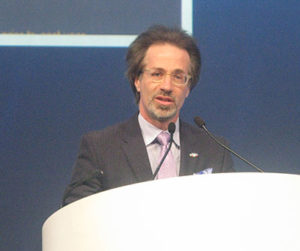
Resorbable microspheres are making waves in musculoskeletal (MSK) embolization, challenging the use of permanent embolics. As clinical evidence supporting their safety and efficacy accelerates, these agents could reshape treatment strategies— offering effective pain relief while reducing long-term risks. In an interview with Interventional News, Ziv Haskal (University of Virginia, Charlottesville, USA) gives pragmatic shape to the emerging future of resorbable microspheres in MSK embolization.
IN: Why are resorbable microspheres in the spotlight, particularly for MSK embolization?
We’ve danced around resorbable embolics for decades, mostly for hepatocellular carcinoma and fibroid embolization—and trauma of course. Thus far, there have been no proven therapeutic advantages for resorbables over permanent embolics for tumours, be they benign or malignant. But that does not mean that this paradigm cannot shift. Consider Kichang Han (Yonsei University College of Medicine, Seoul, South Korea) et al’s September 2024 publication titled ‘Resorbable microspheres versus trisacryl gelatin microspheres for uterine artery embolization’ which showed equivalent outcomes. Wouldn’t any woman considering uterine artery embolization (UAE) now lean toward a resorbable agent?
Until this decade, we’ve had a dearth of calibrated resorbable microspheres with task-specific dissolution characteristics, because of both technical innovation and clear opportunity. MSK embolization has remade that landscape. I remind readers how controversial Yuji Okuno’s (Okuno Clinic, Tokyo, Japan) groundbreaking early papers were. As the two-term Journal of Interventional Radiology (JVIR) editor, I discussed his 2013 seven patient imipenem/ cilastatin genicular artery embolization (GAE) paper with nine reviewers and editors, and all insisted the paper was preposterous and should be rejected: an antibiotic injected intra-arterially? Used as an embolic? For treating arthritis? I published it anyway because it was a well done range-finding study—and the scientific literature is a place for controversy and discussion. It’s already been cited 100 times.
Fast forward to now and the literature has been steadily accumulating, mostly in clear support of MSK embolization of the neovessels that develop in inflammatory conditions, be they osteoarthritis (OA), epicondylitis, frozen shoulder or other enthesopathies and tendinopathies—all intended to provide meaningful control of pain. My own partly torn rotator cuff was overlaid by painful adhesive capsulitis that cost me eight months of rehab and recovery; I might have had a different outcome had I lived in Japan and seen Okuno.
Imipenem/cilastatin is essentially a rapidly dissolving crystal—a short-term mechanical embolic. Amazingly, the clinical effects of MSK embolization are lasting six months to a year—using these rapidly disappearing agents, suggesting that the treated neovessels might remain embolized, beyond the recanalisation of normal vessels, but it’s still an area for deep inquiry. Over-embolization can lead to skin and muscle changes and injury, wounds, and prolonged pain. Beyond proof of concept, imipenem is a therapeutic dead end. There will never be an on-label indication, pursued by a pharmaceutical company, for an antibiotic to be approved as an intra-arterial embolic agent. Forget about it. So, we are in the post-imipenem panorama, where a number of resorbable agents are planned for MSK embolization evaluations. There are a lot of skunkworks on this.
IN: Are you in favour of a ‘leave nothing behind’ approach for embolics?
The European Union has at least one widely available rapidly resorbable CE-marked microsphere (Nexsphere F)—I expect others to arrive shortly. US physicians are lagging; we are still limited to permanent embolics. Therapeutic improvement with MSK embolization is certainly achieved with permanent embolics. But the margins of safety surrounding efficacy are much narrower with permanent embolics. When this procedure spreads in ‘the wild’, e.g., is performed widely, then adverse events will definitely increase with permanent embolics only. Okuno has even identified safety differences between three different temporary agents that he’s used.
Thus, we have to maximise safety— excessive embolization will cause skin and nerve injury, pain, and worse. The blowback could stop this in its tracks—pounced upon, “Aha!” by sceptical other specialties and reluctant insurers. Medicine is tribal, and competing therapies are always under unique scrutiny. Even though I’m a sceptical clinical trialist by nature, I’m a believer in this, so we have to proceed methodically and protect our patients and outcomes, because we have millions of patients suffering with painful presurgical OA, joint and tendon pains and injuries—areas where we might provide a meaningful alternative to failing oral or injection therapies.
“Even though I’m a sceptical clinical trialist by nature, I’m a believer in this, so we have to proceed methodically and protect our patients and outcomes, because we have millions of patients suffering with painful presurgical OA”
IN: A change in technological approach often requires refinement in technique. Is this likely true of embolics in MSK interventions?
Safety, safety, safety—repeat the mantra like a scratched vinyl record. In areas of competitive interventions across multiple specialties, it’s paramount. Endless interventional radiology (IR) examples exist. Consider prostatic artery embolization (PAE)—a procedure designed by interventional radiologists, sought by men, performed in a space owned by urologists. I have been performing PAE continuously for more than 10 years, starting out under our investigator-sponsored investigational device exemption (IDE). Even now, I hear some urologists still describing the procedure as dangerous and investigatory and some US insurers deny it in nearly every case. When you are innovating in your own specialty space, the parameters are different than when you’re under the suspicious watch of others. So, this means primum non nocere—first, do no harm—and proventus scientificus immaculatus esse debet—the scientific results must be immaculate. Hence fast-dissolving resorbables.
IN: Regarding ‘first, do no harm’—does resorbability need to prove repeatability?
Prospective trials are being conducted and are imminent worldwide. There are commercial US trials evaluating permanent embolics for GAE. There are pending commercial trials for resorbable agents—some in ‘quiet mode’—or seeking federal funding. The Nexsphere-F RESORB multicentre IDE trial has been approved by the US Food and Drug Administration (FDA) and will be enrolling patients shortly.
The embolic is a rapidly dissolving gelfoam microsphere that mechanically dissociates at a rate mimicking imipenem/cilastatin by design. It has been included in trials in South Korea and several multicentre trials set to launch in Europe, as well as a UK National Health Service (NHS) trial. It’s also being used in shoulders and elbows. I expect similar trials with other resorbables and liquids. This multi-front approach is critical—to fully evaluate and protect this field we need a variety and multitude of replicative trials and populations.
IN: There are several resorbable embolics being examined in trial settings so far. What do you think needs to happen to differentiate between their safety and effectiveness?
I hope we’ll see strong positive results from multiple resorbable agents. It’s a moving target, as we are also working out the techniques of MSK embolization. How much to embolize, how many vessels, and what are the patient and angiographic-specific embolization endpoints that result in valuable symptom improvement, while avoiding injury. To provide meaningful pain relief in the knee, we might have to treat more vessels than originally thought. There is plenty of opinion, discourse, and argument. What qualifies as an angiographic ‘blush’ warranting treatment? How much do you embolize those vessels—as embolization short of injury is paramount and agent-specific endpoints will vary, as will angiographic embolization endpoints? It’s a recipe for a dog’s breakfast.
IN: Where is standardisation of technique in this landscape? Is GAE a standardised technique?
We published a Society of Interventional Radiology (SIR) Research Reporting Standard for GAE and specifically dodged that question; it’s simply too early to answer. We’ll gradually build that answer upon the empirical results of as many resorbable trials as we can get.










